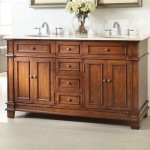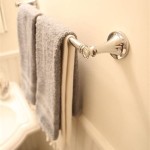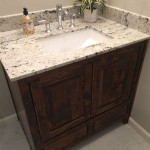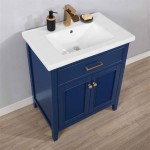Brass Bathroom Sink Drain: A Comprehensive Guide
The selection of a bathroom sink drain is a crucial decision that influences both the functionality and aesthetics of the overall bathroom design. Among the various materials available, brass stands out as a popular choice for its durability, corrosion resistance, and classic appeal. This article provides a detailed exploration of brass bathroom sink drains, covering their attributes, types, installation considerations, and maintenance requirements.
The Allure of Brass in Bathroom Fixtures
Brass, an alloy composed primarily of copper and zinc, offers a unique combination of properties that make it well-suited for bathroom fixtures. Its inherent resistance to corrosion arises from the formation of a protective oxide layer on its surface, effectively preventing degradation from exposure to water and humidity, common elements in a bathroom environment. Furthermore, brass possesses a natural antimicrobial effect, inhibiting the growth of certain bacteria and contributing to a more hygienic bathroom space. The material's malleability allows for intricate designs and shapes, ensuring compatibility with a wide range of sink styles. The inherent color of brass and its ability to be polished to a high sheen also contributes to the aesthetic appeal of bathroom fixtures constructed from this material.
The durability of brass is another crucial factor. The material can withstand the rigors of daily use, maintaining its integrity and appearance over extended periods. This longevity translates to cost-effectiveness in the long run, as brass fixtures require less frequent replacement compared to those made from less durable materials. The timeless aesthetic of brass also contributes to its enduring appeal, making it a versatile choice that complements both traditional and contemporary bathroom designs.
Types of Brass Bathroom Sink Drains
Brass bathroom sink drains come in a variety of types, each designed to meet specific needs and preferences. Understanding the nuances of each type is essential for making an informed decision.
Pop-Up Drains: Pop-up drains are characterized by a lever mechanism, typically located behind the faucet, that controls the opening and closing of the drain stopper. This mechanism allows for easy filling and draining of the sink without the need to manually remove the stopper. Pop-up drains are widely available and offer a convenient and user-friendly solution for most bathroom sinks. Brass pop-up drains offer an added level of durability and aesthetic appeal compared to their plastic counterparts. The internal mechanisms of pop-up drains can vary, with some featuring all-metal construction for increased longevity. Regular cleaning of the pop-up mechanism is crucial to prevent the buildup of debris that can impede its function.
Lift-and-Turn Drains: Lift-and-turn drains feature a stopper that can be lifted and turned to open or close the drain. This type of drain typically lacks an external lever, offering a cleaner and more streamlined look compared to pop-up drains. Lift-and-turn drains are relatively simple in design, which can contribute to their reliability. Installation is also generally straightforward. However, some users may find the manual operation of the stopper less convenient than the lever mechanism of a pop-up drain. Brass lift-and-turn drains provide a durable and visually appealing option for those seeking a minimalist aesthetic.
Grid Drains: Grid drains are characterized by a fixed grid or strainer that prevents large objects from entering the drainpipe. Unlike pop-up or lift-and-turn drains, grid drains do not have a mechanism for opening and closing the drain. They are typically used in sinks that are not intended to hold water, such as vessel sinks or sinks that are frequently used for hand washing. Brass grid drains offer a durable and aesthetically pleasing solution for these types of sinks. The grid design must be regularly cleaned to prevent the buildup of hair and other debris that can obstruct water flow.
Flip-Top Drains: Flip-top drains feature a stopper that pivots open and closed with a simple push. This type of drain offers a convenient and hygienic solution for controlling the flow of water in the sink. Flip-top drains are often designed with a simple and modern aesthetic, making them a suitable choice for contemporary bathrooms. Brass flip-top drains provide a durable and stylish option for those seeking a minimalist and functional drain solution. The flip-top mechanism should be inspected and cleaned regularly to ensure smooth operation.
Touch-Activated Drains: Touch-activated drains represent a more modern approach to sink drain control. These drains feature a stopper that opens and closes with a simple touch or push. Often referred to as push-button drains, they offer a clean and seamless aesthetic. The internal mechanism is typically enclosed and protected, which can contribute to their longevity. Brass touch-activated drains contribute to a sophisticated bathroom design, offering durability and a user-friendly experience. The touch-activated mechanism should be checked periodically to confirm its reliable function.
Installation Considerations for Brass Bathroom Sink Drains
Proper installation of a brass bathroom sink drain is essential for ensuring leak-free operation and optimal performance. While professional installation is always recommended, understanding the basic steps involved can empower homeowners to make informed decisions during the process.
Preparation: Before beginning the installation, it is crucial to gather all necessary tools and materials. This typically includes a wrench, pliers, plumber's putty or silicone sealant, a clean cloth, and the new brass sink drain. Ensure that the existing sink and drain opening are clean and free of any debris or old sealant. Turn off the water supply to the faucet to prevent accidental leaks during the installation process. Disconnect the existing drain assembly from the sink and drainpipe, taking care to loosen any connections gently to avoid damaging the plumbing.
Assembly: Most brass sink drains come with multiple parts, including the drain body, stopper, flange, washers, and nuts. Refer to the manufacturer's instructions for the specific assembly sequence. Apply a bead of plumber's putty or silicone sealant to the underside of the flange to create a watertight seal between the flange and the sink. Insert the drain body through the sink opening from below, ensuring that the flange is properly seated on the sink surface. Secure the drain body by tightening the nut and washers from underneath the sink. Avoid over-tightening the nut, as this can damage the drain body or the sink. Ensure that the drain stopper is functioning correctly and that the linkage, if present, is properly connected to the faucet lever.
Connection: After the drain body is securely installed, connect the drainpipe to the tailpiece of the drain assembly. Use a slip-joint connection or other appropriate fitting to create a watertight seal. Tighten the connections securely, but avoid over-tightening. After the drainpipe is connected, turn the water supply back on and check for leaks. If any leaks are detected, tighten the connections further or reapply sealant as necessary. Carefully inspect all connections to confirm they are secure and leak-free.
Troubleshooting: Common issues encountered during installation include leaks, improper stopper function, and difficulty tightening connections. Leaks can often be resolved by tightening connections or reapplying sealant. Improper stopper function may require adjusting the linkage or cleaning the stopper mechanism. Difficulty tightening connections can sometimes be addressed by using a wrench or pliers to provide additional leverage. If any issues persist, consulting a professional plumber is recommended to avoid further damage or complications.
Maintaining the Shine and Functionality of Brass
Proper maintenance is crucial for preserving the appearance and functionality of brass bathroom sink drains. Regular cleaning and preventative measures can significantly extend the lifespan of the fixture.
Regular Cleaning: Routine cleaning is essential for removing soap scum, water spots, and other debris that can accumulate on the surface of the brass. Use a soft cloth or sponge dampened with warm water and mild soap to clean the drain regularly. Avoid abrasive cleaners or scouring pads, as these can scratch or damage the finish of the brass. For stubborn stains or water spots, a mixture of vinegar and water can be used to gently clean the surface. Rinse the drain thoroughly with clean water after cleaning and dry it with a soft cloth to prevent water spots.
Preventative Measures: Implementing preventative measures can help minimize the buildup of debris and prevent clogs in the drain. Use a strainer or drain screen to catch hair, soap scum, and other debris that can clog the drainpipe. Avoid pouring harsh chemicals or drain cleaners down the drain, as these can damage the brass and corrode the plumbing. Regularly flush the drain with hot water to help dissolve any accumulated grease or soap scum. Periodically inspect the drain assembly for leaks or damage and address any issues promptly to prevent further problems.
Polishing: Over time, brass can develop a patina or tarnish due to oxidation. While some individuals appreciate the aged look of tarnished brass, others prefer to maintain its original shine. To polish brass sink drains, use a commercial brass cleaner or a homemade solution of lemon juice and baking soda. Apply the cleaner or solution to the brass surface and rub gently with a soft cloth. Rinse the drain thoroughly with clean water and dry it with a soft cloth to restore its shine. Remember to follow the manufacturer's instructions for any commercial brass cleaners, and test any homemade solutions on a small, inconspicuous area before applying them to the entire drain.
Professional Maintenance: For more complex maintenance tasks, such as repairing leaks or replacing damaged parts, consider consulting a professional plumber. A plumber can accurately diagnose any issues and perform the necessary repairs without causing further damage to the plumbing. Regular professional maintenance can help extend the lifespan of the brass bathroom sink drain and ensure its continued functionality.

American Imaginations Ai 20331 2 6 In W Brass Bathroom Sink Drain Gold

Classic Pop Up Drain With Overflow For Bathroom Sinks Solid Brass In Gold Homary Ca

Kingston Brass Complement Kb6007 Push Pop Up Bathroom Sink Drain With Overflow

Luxier 1 2 In Brass Bathroom And Vessel Sink Push Pop Up Drain Stopper With No Overflow Brushed Gold Ds03 Tg The Home Depot

Premier Copper S Brass Bathroom Sink Pop Up Drain D 208pb Rona

Kingston Brass Grid Bathroom Sink Drain Without Overflow Brushed Hkb4007 The Home Depot

Kingston Brass Complement Kb6008 Push Pop Up Bathroom Sink Drain With Overflow

Pf Waterworks Decodrain Polished Brass Bathroom Sink Drain Kit In The Drains Stoppers Department At Com

Polished Chrome Bathroom Sink Drain Pop Up Overflow Hole Brass Lavatory Vanity Stopper

Pop Up Bathroom Sink Drain 1 2
Related Posts







